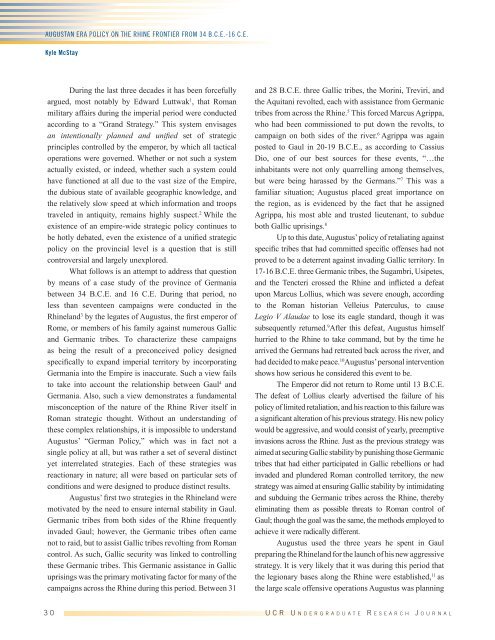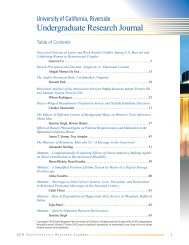UC Riverside Undergraduate Research Journal
UC Riverside Undergraduate Research Journal
UC Riverside Undergraduate Research Journal
You also want an ePaper? Increase the reach of your titles
YUMPU automatically turns print PDFs into web optimized ePapers that Google loves.
Augustan Era Policy on the Rhine Frontier from 34 B.C.E.-16 C.E.<br />
Kyle McStay<br />
During the last three decades it has been forcefully<br />
argued, most notably by Edward Luttwak 1 , that Roman<br />
military affairs during the imperial period were conducted<br />
according to a “Grand Strategy.” This system envisages<br />
an intentionally planned and unified set of strategic<br />
principles controlled by the emperor, by which all tactical<br />
operations were governed. Whether or not such a system<br />
actually existed, or indeed, whether such a system could<br />
have functioned at all due to the vast size of the Empire,<br />
the dubious state of available geographic knowledge, and<br />
the relatively slow speed at which information and troops<br />
traveled in antiquity, remains highly suspect. 2 While the<br />
existence of an empire-wide strategic policy continues to<br />
be hotly debated, even the existence of a unified strategic<br />
policy on the provincial level is a question that is still<br />
controversial and largely unexplored.<br />
What follows is an attempt to address that question<br />
by means of a case study of the province of Germania<br />
between 34 B.C.E. and 16 C.E. During that period, no<br />
less than seventeen campaigns were conducted in the<br />
Rhineland 3 by the legates of Augustus, the first emperor of<br />
Rome, or members of his family against numerous Gallic<br />
and Germanic tribes. To characterize these campaigns<br />
as being the result of a preconceived policy designed<br />
specifically to expand imperial territory by incorporating<br />
Germania into the Empire is inaccurate. Such a view fails<br />
to take into account the relationship between Gaul 4 and<br />
Germania. Also, such a view demonstrates a fundamental<br />
misconception of the nature of the Rhine River itself in<br />
Roman strategic thought. Without an understanding of<br />
these complex relationships, it is impossible to understand<br />
Augustus’ “German Policy,” which was in fact not a<br />
single policy at all, but was rather a set of several distinct<br />
yet interrelated strategies. Each of these strategies was<br />
reactionary in nature; all were based on particular sets of<br />
conditions and were designed to produce distinct results.<br />
Augustus’ first two strategies in the Rhineland were<br />
motivated by the need to ensure internal stability in Gaul.<br />
Germanic tribes from both sides of the Rhine frequently<br />
invaded Gaul; however, the Germanic tribes often came<br />
not to raid, but to assist Gallic tribes revolting from Roman<br />
control. As such, Gallic security was linked to controlling<br />
these Germanic tribes. This Germanic assistance in Gallic<br />
uprisings was the primary motivating factor for many of the<br />
campaigns across the Rhine during this period. Between 31<br />
and 28 B.C.E. three Gallic tribes, the Morini, Treviri, and<br />
the Aquitani revolted, each with assistance from Germanic<br />
tribes from across the Rhine. 5 This forced Marcus Agrippa,<br />
who had been commissioned to put down the revolts, to<br />
campaign on both sides of the river. 6 Agrippa was again<br />
posted to Gaul in 20-19 B.C.E., as according to Cassius<br />
Dio, one of our best sources for these events, “…the<br />
inhabitants were not only quarrelling among themselves,<br />
but were being harassed by the Germans.” 7 This was a<br />
familiar situation; Augustus placed great importance on<br />
the region, as is evidenced by the fact that he assigned<br />
Agrippa, his most able and trusted lieutenant, to subdue<br />
both Gallic uprisings. 8<br />
Up to this date, Augustus’ policy of retaliating against<br />
specific tribes that had committed specific offenses had not<br />
proved to be a deterrent against invading Gallic territory. In<br />
17-16 B.C.E. three Germanic tribes, the Sugambri, Usipetes,<br />
and the Tencteri crossed the Rhine and inflicted a defeat<br />
upon Marcus Lollius, which was severe enough, according<br />
to the Roman historian Velleius Paterculus, to cause<br />
Legio V Alaudae to lose its eagle standard, though it was<br />
subsequently returned. 9 After this defeat, Augustus himself<br />
hurried to the Rhine to take command, but by the time he<br />
arrived the Germans had retreated back across the river, and<br />
had decided to make peace. 10 Augustus’ personal intervention<br />
shows how serious he considered this event to be.<br />
The Emperor did not return to Rome until 13 B.C.E.<br />
The defeat of Lollius clearly advertised the failure of his<br />
policy of limited retaliation, and his reaction to this failure was<br />
a significant alteration of his previous strategy. His new policy<br />
would be aggressive, and would consist of yearly, preemptive<br />
invasions across the Rhine. Just as the previous strategy was<br />
aimed at securing Gallic stability by punishing those Germanic<br />
tribes that had either participated in Gallic rebellions or had<br />
invaded and plundered Roman controlled territory, the new<br />
strategy was aimed at ensuring Gallic stability by intimidating<br />
and subduing the Germanic tribes across the Rhine, thereby<br />
eliminating them as possible threats to Roman control of<br />
Gaul; though the goal was the same, the methods employed to<br />
achieve it were radically different.<br />
Augustus used the three years he spent in Gaul<br />
preparing the Rhineland for the launch of his new aggressive<br />
strategy. It is very likely that it was during this period that<br />
the legionary bases along the Rhine were established, 11 as<br />
the large scale offensive operations Augustus was planning<br />
30 <strong>UC</strong>R Un d e r g r a d u a t e Re s e a r c h Jo u r n a l














